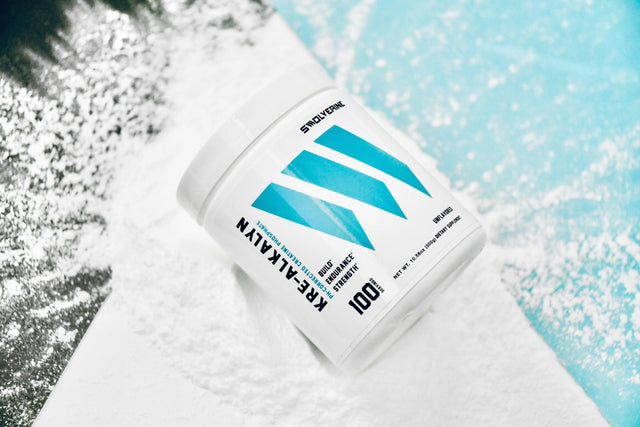In a world where fitness enthusiasts are constantly searching for that extra edge, stenabolic is making waves as a game-changer for endurance and fat loss. Known for its unique properties, this powerful compound has become a go-to for those aiming to push their limits and achieve their fitness goals. Whether you're an athlete looking to enhance your performance or someone striving to shed unwanted pounds, understanding stenabolic could be your key to unlocking new levels of success.
In this ultimate guide, we'll delve deep into the science behind stenabolic, explore its benefits, and provide practical tips for incorporating it into your routine. Get ready to transform not just your workouts, but your entire approach to health and fitness. Let's dive into the remarkable potential of stenabolic and how it can help you redefine your limits!
The Science Behind Stenabolic (SR9009)
Stenabolic, also known as SR9009, is a synthetic metabolic modulator originally developed by Professor Thomas Burris at The Scripps Research Institute, the largest nonprofit biomedical research institute in the U.S., holding over 1,100 patents and 11 FDA-approved drugs. Despite being frequently mistaken for a selective androgen receptor modulator (SARM), Stenabolic is, in fact, a circadian nuclear receptor agonist that targets REV-ERBα, a key regulatory component of the circadian clock.
What Is Stenabolic and How Does It Work?
Stenabolic is a Rev-ErbA ligand, meaning it binds to and activates REV-ERBα and REV-ERBβ—members of the nuclear receptor family responsible for regulating the circadian rhythm, metabolism, and energy homeostasis. By activating these receptors, Stenabolic influences various physiological processes such as:
- Fatty acid oxidation
- Glucose metabolism
- Mitochondrial biogenesis
- Cardiac function
Enhanced Mitochondrial Activity
One of the hallmark features of SR9009 is its ability to boost mitochondrial function. Studies have shown that SR9009 increases both the number and efficiency of mitochondria in skeletal muscle, resulting in higher energy output, improved endurance, and reduced fatigue. This mitochondrial enhancement helps muscles work longer and harder during physical activity Burris, Nature Medicine, 2012.
Metabolic Benefits and Fat Utilization
SR9009 enhances REV-ERB activity to increase fatty acid oxidation, thereby promoting the use of stored fat as fuel. This not only supports fat loss but also contributes to a leaner body composition. Additionally, SR9009 helps improve glucose uptake and insulin sensitivity, making the body more efficient at utilizing carbohydrates without promoting fat storage.
“Activation of Rev-erbα by SR9009 leads to increased energy expenditure and reduced fat mass, without affecting food intake”
— Solt et al., Nature Medicine, 2012 (Link)
REV-ERBs and Circadian Regulation
To understand how Stenabolic works, it's essential to grasp the role of nuclear receptors and circadian biology. Nuclear receptors are transcription factors that regulate gene expression and metabolic processes such as:
- Hormone response
- Development
- Muscle remodeling
REV-ERBα and REV-ERBβ are core components of the molecular clock. They help maintain the 24-hour physiological cycle, influencing sleep, metabolic rate, and cardiovascular health. Disruption of circadian rhythms has been strongly linked to metabolic disorders and cardiovascular diseases Zhang et al., Journal of Clinical Investigation, 2015.
Cardiovascular and Protective Effects
Beyond metabolism, Stenabolic exhibits cardioprotective properties. Research indicates that SR9009 can mitigate cardiac remodeling and reduce pressure overload in conditions like transverse aortic constriction, a model for heart failure. This highlights its potential as a therapeutic agent for cardiovascular disease, especially those tied to circadian rhythm dysfunction Sitaula et al., Endocrinology, 2015.
SR9009 (Stenabolic) is a unique metabolic enhancer that targets the REV-ERBα/β nuclear receptors, playing a pivotal role in:
- Increasing mitochondrial function
- Enhancing fat burning and energy expenditure
- Supporting heart health
- Synchronizing circadian rhythms
While more human studies are needed, current research in animal and cellular models indicates strong potential for improving athletic performance, metabolic health, and even cardiac function.
Benefits of Stenabolic (SR9009) for Endurance Athletes
Stenabolic (SR9009) has gained attention for its performance-enhancing potential. As a Rev-Erbα agonist, it influences multiple physiological systems critical to endurance, metabolism, recovery, and fat loss. Below, we explore its science-backed benefits for athletes and active individuals.
Cardiovascular Health and Cardiac Repair
Pre-clinical research demonstrates that SR9009 may promote cardiac tissue repair following myocardial infarction (heart attack) by reducing inflammation associated with reperfusion injury. These injuries occur when blood supply returns to the heart after ischemia (oxygen deprivation), causing oxidative stress and tissue damage. Short-term targeting of Rev-Erbα has shown long-term benefits in heart repair and inflammation reduction post-ischemia in animal models Sitaula et al., Endocrinology, 2015.
Exercise Mimetic Effects and Endurance Capacity
Stenabolic is considered an exercise mimetic—a compound that mimics the effects of physical exercise at a cellular level. It improves cardiovascular performance, enhances energy metabolism, and stimulates mitochondrial biogenesis in skeletal muscle. Studies in mice reveal that activation of Rev-Erbα increases oxidative muscle activity and endurance by boosting mitochondrial density Solt et al., Nature Medicine, 2012. This is especially impactful in muscle types with high oxidative capacity, like those used during long-duration aerobic activity.
AMPK Pathway Activation
SR9009 also interacts with the AMPK (AMP-activated protein kinase) pathway—an energy sensor that increases glucose uptake, fatty acid oxidation, mitochondrial health, and muscle performance, while reducing inflammation. These exercise-mimetic properties are among the reasons why the World Anti-Doping Agency (WADA) has banned SR9009 due to its potent ergogenic effects on endurance and fat metabolism WADA Prohibited List, 2024.
Tumor Suppression and Anti-Cancer Potential
Emerging studies suggest that SR9009 may have anti-cancer effects, particularly against glioblastoma multiforme, a highly aggressive brain tumor. By reducing reactive oxygen species (ROS) and interfering with cell cycle progression, SR9009 impairs tumor cell viability and metabolism. This cytotoxicity is thought to stem from its modulation of the tumor-intrinsic circadian clock, disrupting metabolic pathways crucial for cancer cell survival Sulli et al., Nature Communications, 2018.
Oxygen Utilization and Aerobic Performance
SR9009 also improves the body's oxygen efficiency, which is critical for athletes engaged in endurance activities like long-distance running, cycling, and swimming. By enhancing mitochondrial performance and reducing fatigue, SR9009 helps sustain high-intensity exertion over longer periods.
Recovery and Inflammation Reduction
Efficient recovery is crucial for performance gains. SR9009 has been shown to reduce systemic inflammation and promote faster muscle repair, enabling athletes to train more frequently and at higher intensities. These recovery-enhancing effects stem from the compound’s influence on inflammatory cytokines, mitochondrial resilience, and metabolic balance, allowing for quicker return to peak performance.
Stenabolic and Fat Loss: A Metabolic Overview
Increased Basal Metabolic Rate
One of SR9009’s most attractive benefits is its ability to raise basal metabolic rate (BMR). By activating Rev-ErbA, it enhances overall energy expenditure—even at rest. This promotes a caloric deficit and accelerates fat loss when paired with proper nutrition and training.
Enhanced Fatty Acid and Glucose Metabolism
SR9009 improves both fatty acid oxidation and glucose metabolism. This dual action prevents excess glucose from converting into fat and helps break down stored fat more efficiently—particularly in stubborn areas like the abdomen and thighs.
Anti-Inflammatory Impact on Fat Storage
Chronic inflammation is a known contributor to obesity and metabolic dysfunction. SR9009’s anti-inflammatory properties further support fat loss by restoring metabolic balance and improving insulin sensitivity Mohawk et al., Cell Metabolism, 2019.
Stenabolic (SR9009) presents a compelling option for endurance athletes and those seeking metabolic improvements. Its benefits include enhanced mitochondrial function and oxygen utilization, increased endurance and exercise capacity, accelerated recovery and reduced inflammation, improved fat metabolism and lean muscle support, and potential anti-cancer effects via circadian clock modulation. While human studies are still limited, the preclinical evidence supports SR9009 as a powerful performance enhancer and metabolic regulator with far-reaching implications in both sports and health.
Recommended Dosage and Administration of Stenabolic (SR9009)
Understanding the correct dosage and administration of Stenabolic (SR9009) is essential to maximize its potential benefits while minimizing potential risks. SR9009 is typically administered orally, and its effects are dose-dependent.
Standard Dosage Guidelines
The generally recommended dosage for most users ranges between 10 to 30 milligrams per day. Beginners are advised to start at the lower end of the spectrum—around 10 mg per day—to assess individual tolerance and responsiveness. Gradual increases can then be made based on goals and how the body adapts.
Dosing Frequency and Timing
Due to its relatively short half-life, SR9009 requires multiple daily doses to maintain stable plasma levels. A common protocol is to divide the total daily intake into two to three equal doses, taken approximately every 4 to 6 hours. For example, a 20 mg daily dosage might be split into 10 mg in the morning and 10 mg in the afternoon, ensuring a more consistent and sustained effect throughout the day.
Cycling Protocol
To prevent the development of tolerance and reduce potential side effects, Stenabolic should be taken in cycles. A typical cycle ranges from 8 to 12 weeks, followed by a minimum 4-week break. This rest period allows the body to reset and recover from continuous use, reducing the likelihood of long-term adverse outcomes.
Medical Oversight and Safety Considerations
As with any research chemical or performance-enhancing compound, it is crucial to consult a healthcare provider before starting SR9009—especially for individuals with underlying medical conditions or those currently using other medications. Despite promising pre-clinical research, SR9009 is not FDA-approved for human consumption, and caution should be exercised when considering its use.
Potential Side Effects and Risks of Stenabolic (SR9009)
While Stenabolic offers numerous metabolic and performance benefits, it’s important to understand the potential risks and side effects associated with its use. Being aware of these factors ensures safer and more informed usage, especially in long-term or performance-driven contexts.
Disrupted Sleep and Circadian Rhythm Interference
Because Stenabolic directly influences the circadian rhythm through Rev-Erbα activation, one of the most common user-reported side effects is disrupted sleep. This may present as insomnia, difficulty falling asleep, or altered sleep patterns. To minimize this, avoid taking doses close to bedtime and aim to maintain a consistent sleep-wake cycle.
Liver Health and Toxicity Risk
Some preclinical studies have suggested that high doses of SR9009 may impact liver enzyme levels, potentially leading to hepatotoxicity in certain models Mohawk et al., Cell Metabolism, 2019. To mitigate this, it’s critical to follow recommended dosages, avoid prolonged cycles, and monitor liver function with periodic blood tests when possible.
Gastrointestinal Discomfort
Although generally well tolerated, some individuals may experience gastrointestinal side effects, including nausea, diarrhea, or abdominal discomfort, particularly at the start of a cycle. Users should listen to their bodies and reduce the dose or discontinue use if side effects persist. Severe symptoms should prompt immediate medical consultation.
Individual Variation
As with any supplement or experimental compound, individual responses to Stenabolic vary. Genetic factors, underlying health conditions, and concurrent supplements or medications can all influence how the body reacts. Always consult a healthcare professional before initiating use, especially if you have preexisting conditions or are taking prescription drugs.
Stenabolic vs. Other Fat Loss Supplements: A Comparison
Stenabolic vs. Caffeine
Caffeine is one of the most widely used fat-loss aids due to its thermogenic effects and ability to increase energy and alertness. However, caffeine’s effects are often short-lived, and tolerance can develop over time, diminishing results. Stenabolic offers sustained metabolic benefits by boosting mitochondrial function and fatty acid oxidation, making it a longer-lasting alternative.
Stenabolic vs. Green Tea Extract
Green tea extract, rich in catechins, supports fat oxidation and mild increases in metabolic rate. Though effective, its impact on fat loss is typically more modest compared to SR9009. Stenabolic's ability to enhance energy expenditure, glucose metabolism, and exercise capacity gives it a more powerful profile for those seeking significant fat reduction.
Stenabolic vs. Thermogenics
Thermogenic fat burners often contain a blend of caffeine, green tea extract, and capsaicin, and work by raising body temperature and metabolic rate. However, they are frequently associated with side effects like jitteriness, elevated heart rate, and digestive upset. Stenabolic offers a non-stimulant, performance-enhancing alternative with fewer acute side effects and a unique mechanism of action that targets mitochondrial function rather than relying on central nervous system stimulation.
Legal Status and Regulations Surrounding Stenabolic
FDA and Research Classification
Stenabolic (SR9009) is not approved by the U.S. Food and Drug Administration (FDA) for medical use and is classified as a research chemical. While legally available for purchase, it is not intended for human consumption and should only be sourced from reputable vendors for research purposes. Purity and quality verification are essential to avoid harmful contaminants or mislabeled products.
WADA Prohibition for Athletes
The World Anti-Doping Agency (WADA) has included SR9009 on its Prohibited List due to its potential for performance enhancement WADA Prohibited List, 2024. Athletes competing in WADA-governed events are strictly forbidden from using SR9009, and violations can lead to disqualification, suspension, or loss of titles.
Global Variability in Legal Status
Laws surrounding SR9009 vary internationally. In some countries, it may be controlled or banned entirely. Users should research and stay informed about the specific regulations in their country or region before considering use. Understanding the legal and ethical implications is vital, especially for competitive athletes or professionals in regulated industries.
Clinical Research and Side Effect Profile of Stenabolic (SR9009)
Lack of Human Clinical Trials
As of now, no human clinical trials have been conducted on SR9009. This absence of clinical data means that potential side effects are primarily derived from anecdotal reports and animal studies, making it difficult to establish a definitive safety profile for human use.
Anecdotal Side Effects
Reported user experiences suggest several mild to moderate side effects, including:
- Nausea
- Headache
- Increased wakefulness
- Difficulty sleeping
These effects are likely linked to SR9009's interaction with the circadian rhythm and its influence on metabolic regulation. Sensitivity may vary depending on the dose and timing of administration.
Post Cycle Therapy (PCT) Not Required
Unlike anabolic steroids or selective androgen receptor modulators (SARMs), SR9009 is a metabolic modulator, not a hormone modulator. It does not suppress natural testosterone production or disrupt endocrine function, so post cycle therapy (PCT) is not required following its use.
Undetermined Optimal Dosage
Although ergogenic benefits have been observed in preclinical settings, the optimal dosage for humans remains undetermined due to the lack of formal studies. Dosage recommendations are based on anecdotal reports and extrapolation from animal models, and should be approached with caution.
Conclusion: Is Stenabolic Right for You?
In conclusion, stenabolic presents a powerful option for those seeking to enhance endurance and achieve significant fat loss. Its unique mechanism of action, which involves increasing mitochondrial activity and promoting fatty acid oxidation, sets it apart from other supplements. The benefits for endurance athletes, including improved stamina, better oxygen utilization, and faster recovery, make it an attractive choice for those looking to push their performance to new heights.
For individuals aiming to lose weight, stenabolic offers a comprehensive solution by boosting metabolic rate, enhancing glucose metabolism, and reducing inflammation. These effects contribute to effective fat loss and improved overall metabolic health. However, it's important to remember that while stenabolic can provide substantial benefits, it should be used responsibly and in conjunction with a balanced diet and regular exercise.
Ultimately, the decision to use stenabolic should be made after careful consideration of its potential benefits, risks, and legal status. Consulting with a healthcare professional is essential to ensure that it aligns with your individual health needs and goals. By approaching stenabolic with informed awareness and responsibility, you can unlock its remarkable potential and transform your fitness journey.
Find similar articles:
SARMS






